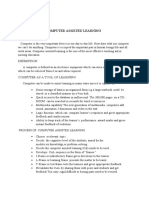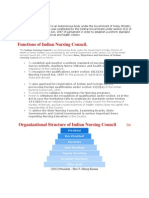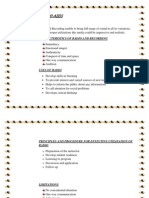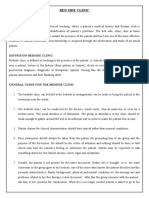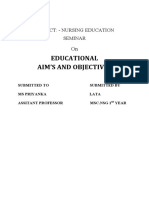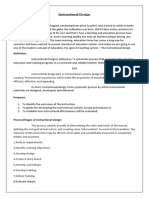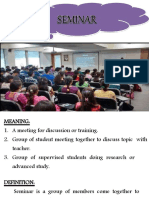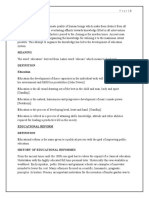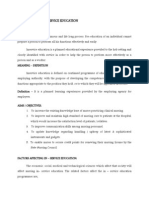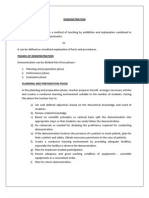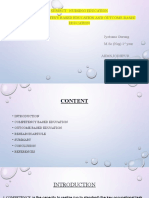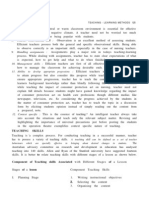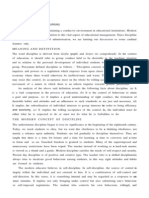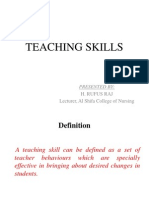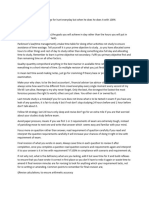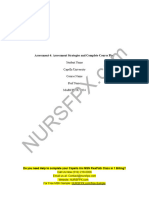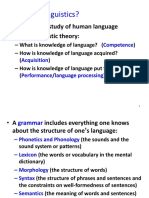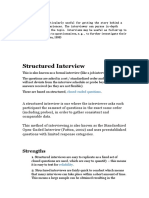SIMULATION
PRESENTED BY: H. RUFUS RAJ Lecturer, Al Shifa college of Nursing
�Definition
Simulation is a teaching technique used particularly in
management education and training in which a 'real
life situation' and values are simulated by 'substitute' displaying similar characteristics.
Simulation is defined as an operating representation of central features of reality.
�Purposes
To help students practice decision making and problem solving skills To develop human interaction abilities in a controlled and safe setting.
To achieve cognitive, affective and psychomotor outcomes
To provide a chance to apply principles and theories To learn and test various approaches in a setting To transfer knowledge to the real patient care settings
�Values
Ensures safe nursing practice by nursing students through bridging the gap between theory and practice Simulation is an effective technique to learn psychomotor skills Helps the students to develop critical thinking abilities and problem solving skills Helps the students to learn the decision making process but also provides feedback regarding the consequences of the decisions made Enables students to empathise with the real life situations Teacher can easily inculcate proper attitude among nursing students Used to evaluate students
�Types
Simulation exercise : A controlled representation of a piece of reality that learners can manipulate to better understand the corresponding real situation. Simulation game : A game that represents real life situations in which learners compete according to a set of rules in order to win or achieve an objective. Role playing : A form of drama in which learners spontaneously act out roles in an interaction involving problems or challenges in human relations. Socio drama : seeks to utilize role playing as a means of finding out a solution to a problem situation assigned to the role players.
�Forms of Simulation
TYPE EXAMPLE FIDELITY TYPICAL USE EXAMPLE OF USE
Model simulation Oral simulation Written simulations Computerised simulations Simulated patient
Manikins Problem based Paper & pencil
Low Low Very low
Demonstration practice Case discussions Knowledge assessment teaching Cognitive & problem solving skills teaching Interpersonal skills teaching
CPR manikins Class room discussion Patient management diagnosis Clinical management Simulated burns patient
Micro computer Trained actor role play
Medium
Very high
�Procedure
1. Selection of role players: 4-5 members assigned with different roles
2. Selecting & discussion skill: Skills to be practiced are discussed Topics fit in the skill are suggested 3. Planning: Who starts the conversation and who tops the interaction
4. Procedure for evaluation: Proper feedback for the simulation 5. Practical lesson provision: Proper reinforcements should be provided to the role players
�Advantages
Actively engages learners in the application of knowledge & skills Promoting transfer of learning from the class room to the clinical setting Permit application of theory to practice Students can learn without harming the patient that is no risk is involved Provides participants to deal with the consequences of their actions Controlled teaching assignments are possible Decision making skills into action Bridging the gap to reality
�Disadvantages
Time consuming to develop Involve use of sophisticated materials Lessons learned from a particular simulation cannot be blindly applied to another situation or problem. Simulation is expensive in terms of time, money and energy. Emotion laden simulations may cause mental trauma Cause mental trauma to students who are handling negative roles Cannot be made in all subjects of the curriculum Difficulty in using analytic approach Reduces the seriousness of learning Need for use of many simulators
�Role of the Teacher
Planning: Purchase a simulation package or develop an appropriate simulation Ensure the usefulness of the simulation. Facilitating: observe carefully the behaviour of students modify the viewpoints maintain a non judgemental attitude Debriefing: conducted immediately after the simulation. summarises the whole event encourages the participants to do a explains the concepts and principles applied
�MICROTEACHING
�Definition
Micro-teaching is a teacher education technique which allows teachers to apply clearly defined teaching skills to carefully prepared lessons in a planned series of five to ten minutes encounter with a small group of real students, often with an opportunity to observe the result on video tape. Micro teaching is a teacher training procedure which reduces the teaching situation to a simpler and more controlled encounter by limiting the practice teaching to a specific skill and reducing teaching time and class size.
�Objectives
To enable the teacher trainees to learn and assimilate new teaching skills
To gain confidence in teaching
To utilize the academic potential of a teacher
To provide training in in the component skills of
teaching
To gain maximum advantage with little time, money
& material
�Phases
Knowledge acquisition phase:
Observation of analysis Discussion of the demonstrated skills
Skill acquisition phase:
Preparation of the micro lesson involving the skill Practicing the skill while teaching
Transfer phase:
Evaluating the performance leading to feed back Replan, re teach & transfer of skill to actual class teaching in macro sessions
�Five R of microteaching
cording eviewing
esponding
efining edoing
�Principles
Enforcement Reinforcement Practice & drill Continuity
Experimentation
Microscopic supervision
Evaluation
�Micro teaching cycle
Plan micro lesson
Re teach another group
Teach micro lesson
Re plan
Discuss feedback
�Steps
Defining the skill Demonstrating the lesson Planning the lesson Teaching the micro lesson
Discussion on the lesson delivered
Replanning the lesson Reteaching the lesson Rediscussion or refeedback Repeating the skill
�Flow chart for micro teaching
Planning for 5 mins of teaching Microteaching - I 5 mins Discussion with video play back Replan Evaluation sheet video
Microteaching - II 5 mins
Self confirmation
�Characteristics
I. Microelement:
Microteaching reduces the complexity of the teaching situation in terms of: No: of students taught Duration of lesson Subject matter to be taught No: of instructional objectives Reduces size of the topic Prepares effective teachers
Contd
�Contd
II. Teaching skills & teaching strategies:
(a) Pre instructional skills:
Writing instructional objectives Sequencing & organising Appropriate content Selection of AV aids Proper organisation
(b) Instructional skills:
Skills of introducing a lesson Skills of explaining & illustrating Reinforcement Probing questions Diagnosing difficulties
(c) Post instructional skills:
Skills of writing test items Interpreting students performance Planning remedial measures
(d) Feedback
Contd
�Contd
III. Safe practice ground:
Teaching is performed under simulated conditions
IV. Teaching models:
Many opportunities to study the desired pattern of behaviour through demonstration
V. Research laboratory:
To optimise the procedures & sequencing Research in modelling & supervising techniques Task analysis of teaching act Aptitude treatment interaction studies
�Advantages
Effective in modifying teaching behaviour Increased control of practice Facilitates the development of teaching skills Facilitates the combination of number of AV aids Exemplifies the effective use of technology in the field of education Results in critical analysis & improvement of teaching skills Immediate feedback makes micro-teaching more interesting and reliable Help teachers to acquire hard-to-attain teaching skills by providing a real situation for practising skills Lessens the complexities of the normal class room teaching by scaled down teaching
�Disadvantages
Time consuming in ill-prepared student teacher. Risk of simply imitating a teaching skill Hampering the creativity of the student teacher, More research is needed to ascertain its e usefulness Expensive to procure video recording equipments Limited to lecturing Requires more skill and scope is narrow Not feasible for actual practice if student number exceeds 10
�PROGRAMMED INSTRUCTION
�Definition
Programmed instruction is defined as on individualized instructional strategy for the modification of behaviour used for instructional purpose that can be employed as a mechanism of feed back device for improving teaching efficiency.
Method of designing a reproducible sequence of instructional
events to produce a measurable and consistent effect on
behaviour of each and every acceptable student.
�Principles
Principle of small step: subject matter is broken down into small steps Principle of active responding: student actively responds during the learning process Principle of immediate confirmation : confirmation provides reinforcement to the learner Principle of self pacing : learning process needs adequate
pacing as slow or quick as needed
Principle of student testing : student has to write a response sheet for each step in the process
�Assumptions
Student learns better
by being active by being motivated if the content matter is presented in small steps if commits minimum errors If the sequence of content is psychological valid If the prerequisites are specified
�Objectives
To help the student to learn by doing To provide the situation to learn at his own pace To help student to learn without the presence of teacher To present the content in a controlled manner To present the content in logically related steps To assess own performance
�Characteristics
Not an audio visual device. It is a part of education technology ie. Instructional technology Not a test. It is a strategy for teaching & learning Not a solution for educational problems. It is an instructional strategy for modification of behaviour Cannot the replace the teacher bur effective teacher can prepare a good program Requires more imaginative and creativity efforts
�Steps for development
Selection of the topic Identifying the objectives Content analysis for instructional procedure Writing objectives in behavioural terms Construction of a criterion test
Deciding the strategy of program Revising and editing the program
Master evaluation and preparation of manual
�Advantages
Improved skills of content analysis Improved skills of arranging the content in learning sequence Presentation of the content into small steps Able tp o provide the reinforcement to learn by confirming
their responses
Help to develop the situation for achieving desired learning objectives
Generate the learning situation
Help to identify the objectives & write in behavioural terms


